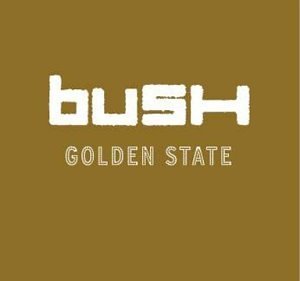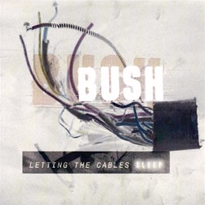
Gavin McGregor Rossdale is a British musician, best known as the lead singer and rhythm guitarist of the rock band Bush. He helped form Bush in 1992; on the band's separation in 2002, he became the lead singer and guitarist for Institute and later began a solo career. He resumed his role in Bush when the band reunited in 2010. In 2013, he received the British Academy's Ivor Novello Award for International Achievement.

Bush are an English rock band formed in London in 1992. Their current lineup consists of lead vocalist and rhythm guitarist Gavin Rossdale, lead guitarist Chris Traynor, bassist Corey Britz, and drummer Nik Hughes.

Sixteen Stone is the debut studio album by English rock band Bush, released on 6 December 1994 by Trauma and Interscope Records. It became the band's most popular album, peaking at number four on the US Billboard 200 and boasting numerous successful singles. "Comedown" and "Glycerine" remain two of Bush's biggest hits to date, each reaching number one on the US Billboard Modern Rock Tracks chart. "Comedown", "Machinehead", and "Glycerine" were the three songs from the album to enter the US Billboard Hot 100, reaching number thirty, number forty-three, and number twenty-eight, respectively. The album was certified 6× Platinum in the United States by the RIAA on 16 April 1997. Although notably less successful in the band's native Britain, the album was nonetheless certified Silver by the British Phonographic Industry.

Distort Yourself is the only studio album by American rock band Institute, led by then-former Bush frontman Gavin Rossdale. Released on September 13, 2005, through Interscope Records, the album was co-produced by Helmet frontman Page Hamilton. The album also produced the single "Bulletproof Skin."

Razorblade Suitcase is the second studio album by English rock band Bush, released on 19 November 1996 by Trauma and Interscope Records. The follow-up to their 1994 debut Sixteen Stone, it was recorded at Abbey Road Studios in London with engineer and producer Steve Albini. Its sound is more raw than that of its predecessor and has frequently been compared to Nirvana's In Utero (1993), which was also produced and engineered by Albini. The album is widely regarded as being the last major "grunge" album of the 1990s.

Deconstructed is a remix album by British band Bush, released on 11 November 1997, through Trauma Records. It did not feature any new material but was a collaborative effort between the band and various producers working in the electronic genre of music to remix some of the band's previously released songs. "Mouth " was released as a single in 1997 and became a minor hit, due largely in part to it being featured prominently in both the trailer and the 1997 film An American Werewolf in Paris.

Golden State is the fourth studio album by the British rock band Bush, released on 23 October 2001 through Atlantic Records. It is the last Bush album to feature Nigel Pulsford and Dave Parsons on guitar and bass, respectively. Bush would not release another studio album again until ten years later with The Sea of Memories. The liner notes of Golden State cite the album in memory of Ian Lowery, founder of Folk Devils. In the documentary Making Of Golden State, the title is revealed as being inspired by the Golden State Freeway, which Gavin Rossdale used to use to get home.

The Best of '94–'99 is a greatest hits double album by British rock band Bush. Disc one consists of the band's hit songs, while disc two is their performance at Woodstock '99. The collection omits their singles "The People That We Love" and "Inflatable" from Golden State, due to lack of licensing rights.

Chris Traynor is an American musician, songwriter and producer, best known as the lead guitarist of the rock band Bush since 2001. Prior to Bush, he started in the post-hardcore scene with Fountainhead and Orange 9mm. “I got a publishing and record deal when I was nineteen, just super young.” Traynor had an on and off stint with Helmet while overlapping his Gavin Rossdale based projects of Bush, Institute, and Gavin Rossdale's solo album. Traynor played in two bands with his partner Sibyl Buck, Champions of Sound and High Desert Fires.

"The Chemicals Between Us" is a song by alternative band Bush. It was released on 14 September 1999 as the lead single from the band's third album The Science of Things (1999). The song was featured in the TV series Charmed.

"Bonedriven" is a song by the British rock band Bush, released on 16 April 1997. It is the third single from the band's second album Razorblade Suitcase (1996). It followed the band's hit singles "Swallowed" and "Greedy Fly." "Bonedriven" and "Cold Contagious" are the only Bush singles from 1994–1999 not to be included on the band's 2005 greatest hits compilation, The Best of '94–'99, apparently excluded in favor of two additional tracks from the band's remix album Deconstructed that were not released as singles.

Wanderlust is the debut solo album by Bush frontman Gavin Rossdale. It is his first studio album since Institute's Distort Yourself in 2005. Rossdale's initial working title for the record was This Place is on Fire, now the moniker for the release's a cappella coda piece. The lead single, "Love Remains the Same," was released digitally on April 1, 2008.

"Letting the Cables Sleep" is the second single from British band Bush's third studio album The Science of Things, which was released in 1999. In an interview, Gavin Rossdale revealed that the song was written for a friend who had contracted HIV.

British rock band Bush has released nine studio albums, one live album, two compilation albums, and 36 singles released on Interscope Records. The band had released four studio albums before separating in 2002. They reunited in 2010 and have since released five studio albums.
David Guy Parsons is a British rock musician who is best known as the original bassist for English grunge band Bush.

The Sea of Memories is the fifth studio album by English alternative rock band Bush, released on 13 September 2011 through Zuma Rock Records, eOne Music and earMUSIC. It is the band's first studio album in ten years, following 2001's Golden State, and the first to be recorded with Chris Traynor and Corey Britz on lead guitar and bass, respectively. It is also the first Bush album released on E1 Records, marking their first venture away from Interscope, who handled all of their previous releases. The album's title comes from a line in the song "Baby Come Home". The cover art is by Los Angeles–based street artist, RETNA.

Man on the Run is the sixth studio album by the British rock band Bush, released on 21 October 2014, through Zuma Rock Records. It marks the band's second studio album to be recorded under its current incarnation, which reformed in 2010 after an eight-year hiatus and released The Sea of Memories in 2011. The album release in 2014 marks the 20th anniversary of the band's debut album, Sixteen Stone.

Black and White Rainbows is the seventh studio album by British alternative rock band Bush, released on 10 March 2017, through Zuma Rock Records and Caroline International. It is the follow-up to the band's 2014 album, Man on the Run, and is the third featuring the lineup of Gavin Rossdale, Robin Goodridge, Chris Traynor and Corey Britz. It is the last album to feature longtime drummer Robin Goodridge, the only member other than Rossdale who had played on every album dating back to their 1994 debut Sixteen Stone which launched the band's career. He was also the only longtime member to rejoin Bush after their hiatus from 2002 to 2010.

The Kingdom is the eighth studio album by English rock band Bush. It was originally scheduled to be released in May 2020 but it was later pushed back to a release date of 17 July 2020. The band released two singles prior to the album, the first being "Bullet Holes" which was released in May 2019 and featured in the film John Wick: Chapter 3 – Parabellum, and the second single off the album was "Flowers on a Grave" and was released one year later in March 2020.

The Art of Survival is the ninth studio album by British alternative rock band Bush. It was released on 7 October 2022 through BMG Records and follows the band's 2020 effort The Kingdom. The album's release was preceded by the lead single "More Than Machines", which reached No. 2 on the US Mainstream Rock charts, with the album itself charting within the Top 100 in Germany, Scotland and Switzerland, spawning two further singles: "Heavy Is the Ocean" and "All Things Must Change".



















